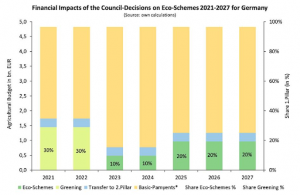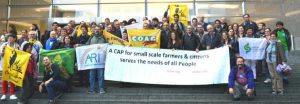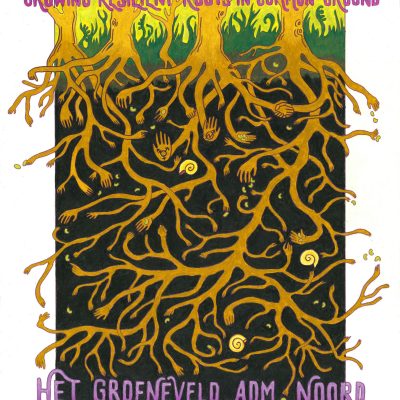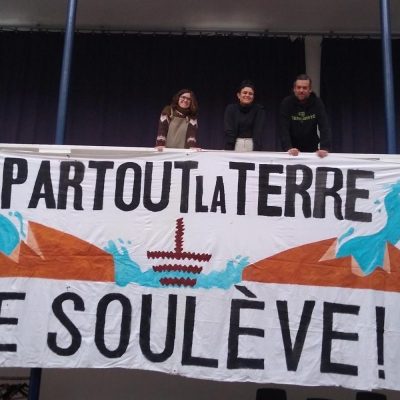After a long week of dramatic negotiations, the MEP’s voted on the CAP reform proposal on the 21st of October. As expected, business as usual for the agro-food industry was proposed. The new CAP agreement does not take into consideration the Farm to Fork or Biodiversity strategy, maintains the 60% direct area-based payments including the ineffective greening regulations of the old CAP, and much more. It is followed by a long list of “reforms” that from afar will not change the already existing European industrial monoculture productionist model.
But what are all these agreements and weird acronyms? When will the new CAP be implemented? What does it mean for small-scale organic farmers? How does it affect consumers?We looked deeply into articles published by several collectives such as Good Food Good Farming, La Via Campesina and the Boerengroep. Further, with the help of friends working at Dutch Administration, comrades studying at Wageningen University and others, we tried to critically summarize some of the key aspects of the new CAP reform proposal.
Common Agricultural Policy (CAP), the two pillars and the common market
The Common Agricultural Policy (CAP) is a European Union policy dedicated to agriculture and rural development. It was implemented in 1962 and was the first budgetary item of the EU. At that time, it aimed at developing agricultural production to feed the European populus after the end of the Second World War, a goal it quickly achieved. However, the steady increase of European production has led to perverse overproduction, pollution, loss of biodiversity and a long list that destroys nature and decreases farmers’ sovereignty.
Since inception, the CAP has been reformed multiple times, most notably in 1992. One key change was the intervention strategy, aligning the CAP to the rules of the World Trade Organisation. The last reform took place in 2014 and the most recent reform negotiation process, for the next 7 year CAP cycle starting in 2021, just came to a close. Today the CAP accounts for approximately 40% of the EU’s budget. It remains the EU’s most integrated policy, i.e. the one with the most decisions made at EU level. https://www.goodfoodgoodfarming.eu/about-cap/
The CAP consists of two ‘pillars’ and the “common markets”. The first pillar includes direct payments (i.e. annual direct payments to farmers) and the eco-schemes (one of the new elements of this CAP). The second pillar concerns rural development policy and is aimed at achieving balanced territorial development and sustaining a farming sector that is environmentally sound, as well as promoting competitiveness and innovation.
– Pillar I → Direct payments/support to farmers 60%
– Pillar II → Rural development and agri-environmental measures 30%
– Common Markets→ EU intervention on agricultural market in cases of crisis 10% |
*The percentages above will be still adjusted in the coming CAP rounds
Long story short on the CAP reform and implementation process
Before getting into details about what happened a month ago, we looked at the whole CAP historical process in order to understand how the EU regulations and the CAP reforms work. The EU regulations define a set of objectives such as competitiveness, short transportation ways, ecosystem governance, etc. These regulations define fundable activities; productive investments, knowledge exchange, young farmers support etc. Overall there are around 60 fundable activities. Later on, each member state develops a National Strategic Plan (NSP) that includes a Funding Strategy choosing priorities and excludes others. Then they pick and choose fundable activities. In theory, a member state can decide to transform the entire agricultural sector of their country towards agroforestry cooperatives if they want. Wouldn’t this be great?

In the current CAP, the National Strategic Plan will define the eco-schemes guidelines in a similar way as described above. The EU will give a list of fundable measures of which every member state will pick and choose. So theoretically, the eco-schemes can be really helpful for ecological small scale farming, or they can be used for AI drones performing 5G precision farming. Guess which direction fits more in a capitalistic system?
And how does this affect small-scale farmers? The opportunity for CAP funding for small scale farming will be determined in two ways: minimum farm/land size and special support. The first one depends on dimensions of the farm/land and each country defines threshold values for funding: For example, in NL, the minimum fundable amount for pillar 2 activities is 20.000€ for reasons of efficiency. Since farmers need to contribute with their own assets, many small farms cannot access the funds because the threshold is too high for them.
Regarding the special support the Pillar 2 regulation contained articles for support of young farmers. Such support includes for example investments for productive investments like machinery in cases of generational transition, or career changers. In the new proposal, there is a move from the parliament and the commission to add women and small scale farm start-ups to this option. But, of course, the big corporations lobby, the ministers of Agriculture and the European Parliament have the last say and we are afraid these proposals will never pass through.

The CAP is reformed every 7 years and it has to pass through 3 different european trilogues; the Commission, the Council of Agricultural Ministers and the European Parliament. Once the Council agrees on the initial petition and the European Parliament votes, the new CAP passes through. This time, the whole CAP process was delayed for 2 years, initially because of the Brexit uncertainty (market uncertainties on the Multiannual Financial Framework MMF), later on because of the Covid-19 crisis and finally because of the agro-food industry lobby pressure.
How does it exactly apply to the current situation? The old CAP regulation, which lay out the rules of the first and second pillar payments, will be extended until the end of 2022. During this 2-year period from 2021 until the end of 2022 there will be a transition period between the old and the new CAP, where the old rules still apply, but member states have the opportunity to alter their national programmes. During this transition phase, countries have to develop their new “National Strategy CAP plan” according to the new CAP agreements.
That means the new CAP reform won’t be fully implemented until 2023. But this is not all; 2023 and 2024 will be a 2 years period of trial and transition regarding the eco-schemes called “learning period”. That means that the eco-scheme, some of the few subsidies that small-scale farmers could apply for, won’t be fully implemented until 2025!
At the first Pillar we already see for so many years one of the biggest injustices, with 80% of the direct payment going to only 20% of the already existing farms (this is not changing in this CAP reform). That means that the vast majority of this direct payment is supporting large landowners, intensive large-scale monoculture farms and land grabbing corporations enabling more land grabbing and the disappearance of family farms. This is one example of how uneffective, unjust, inefficient and inequitable these direct payments are.
Source: CAP Reform: http://capreform.eu/does-capping-direct-payments-make-sense/
A variety of political groups, small farm organisations, and civil society have made countless calls to install a maximum limit to the direct payments (also called ceiling, or cap) that each farm could get. In this way, the payments could then get redistributed towards small operators, rural development projects, or the adoption of greener farming methods. https://corporateeurope.org/en/2020/10/cap-vs-farm-fork
Our friends from Good Food Good Farming together with other civil society organizations called upon the agriculture ministers to replace per hectare payments with the principle of “public money for public services”. https://www.goodfoodgoodfarming.eu/openletter/
In this CAP reform, the Commission finally put forward a proposal of a compulsory ceiling of 100.000€ per farm (in another article we’ll discuss what’s a farm/farmer in the eyes of the Council of Ministers and how they have been shaping definitions and terminologies in order to pass laws). This “compulsory” ceiling is actually a voluntary one (not binding agreement) which means that every country will decide whether or not to implement this regulation. ASEED supports the proposal from the European Coordination of La Via Campesina (ECVC) which proposes a ceiling of 60.000€ per farm. But of course, the corporate agriculture lobby is powerful and closely tied to the main parties within the European Union enabling them to change this mandatory ceiling proposal to a voluntary one. Corporate Europe Observatory investigated this corporate influence within the CAP negotiations. https://corporateeurope.org/en/2020/10/cap-vs-farm-fork

What are exactly the green washing “Eco-Schemes” proposals included at the first CAP pillar?
The eco-scheme is one of the new elements approved in the CAP reform, supposedly to support specific regional and local farmers needs regarding environment and climate ambition. As described in the agreement “it is a measure to reward and incentivise farmers for taking action towards a more sustainable farm and land management with the objective to maintain public goods”.
The eco-scheme is included in Pillar I and accounts for 20%* of this Pillar.Member states are obliged to use this 20% for the eco-schemes but it is an optional measure for farmers that cannot be imposed from above. This means that every country will have to make sure that farmers apply for this subsidy and that this money goes towards this initiative.
*The 20% are still negotiated, there are hopes that it will become 30% during trilogues. https://www.arc2020.eu/eco-scheming-council-adopts-a-cap-position-of-no-ecological-substance/ ).
A practice added within these eco-schemes is ‘precision farming’. This is primarily about the usage of resources such as synthetic fertilizers in a “more efficient way” . This reinforces a farming model based on technology and efficiency that doesn’t take into account the root cause of soil degradation, water pollution, water scarcity and other environmental issues related. https://freethesoil.org/action-creatures-from-the-earth-rise-up-stop-yara/
That said, there is the question of what will happen if there are leftover undistributed payments in this section of the Pilar if too little farmers apply for it. In that case, countries will have the right to re-distribute this money from one Pillar to another making, again, the whole process quite undemocratic and very blurry. On top of this, every country has to present their own National Strategy, defining their own understanding of eco-schemes and leading to their own proposal.
One of our main concerns about the Eco-Schemes and its implementation is not only the unclarity of the description about “environmental friendly practices” but the capacity of implementation for small-scale farmers.The most likely outcome is that large conventional farms with huge capital and strong financial means will be the only ones with capacity to achieve these goals via large investment, while small and medium farmers practicing agroecology will be excluded. For instance, a country that is focused on the agro-food dairy industry with obvious interest on economic growth in this sector regardless of environmental concerns, will present eco-schemes proposals towards this direction focusing on technology, innovation and “sustainability ”. Sadly this will not give any space to other models of farming, such as extensive agriculture, silvopastoralism, regenerative agriculture or other holistic management practices based on agroecology principles which focus on land restoration and traditional ecological knowledge.
To summarise, the eco-schemes proposal is pure greenwashing! The eco-schemes encourage farms towards precision farming, innovations and technology increase. All of these measures focus on competitiveness, yields and soil exploitation. There is barely space for agroecology farming projects working for regenerating the soil. A socio-ecological responsable EU should have the responsibility to ensure that subsidies do not go to farms that tick the box of organic or “sustainable practices” but maintain a totally unsustainable system of industrial farming, overproduction and unsustainable international trade. But obviously, this is not happening. Moving towards agroecology and localised food systems requires measures that address the root causes of the problems. The globalised market determines the agricultural model and it is a mistake to think that eco-schemes alone can bring about sufficient change.https://viacampesina.org/en/cap-reform-good-objectives-insufficient-measuressays-ecvc/
We also think that the eco-schemes can create even more conflict without a proper follow up implementation. If the commission goes ahead with their biodiversity and climate directives without support to adapt to the new directives, farmers will be restricted and penalized even more, ending up not having access to these fundings. And of course, small-scale farmers without much capacity and time for looking into new regulations and restrictions will have less chances to apply for new subsidies than big agro-industry corporations.
Is there still any hope of redirecting the new CAP agreement?

Honestly, not much/.Good to know is that the vote on the 21st of October is not a final agreement, only a proposal. The report has to be reviewed again by the Commission and passed again by the Council of Agricultural Ministers and the European Parliament. With this we hope that the seemingly more ambitious Commission will push again for integration of the biodiversity strategy, the farm to fork strategy and for other more ambitious solutions without giving up on the Green Deal proposals which they were so enthusiastic about a few months ago. This combined with continued pressure from civil society in the form of campaigns such as #WithdrawTheCAP and #GoodFoodGoodFarming, as well as some politicians outside of the three main parties responsible for this monstrosity, may offer a glimpse of hope.
One of the interesting proposals (among many other interesting proposals) that would affect all aspects of the CAP is a proposal on biodiversity and soil testing. Within this, a quantitative evaluation “before, during and after” regarding biodiversity and soil quality was requested. Having these indicators measured throughout the years and denying subsidies if there is no biodiversity improvements would put measurable pressure and accountability onto the food industry to genuinely change their practices.
We’ll keep building connections with other civil society and grassroots organizations in order to fight together for a CAP that represents food sovereignty and agroecology ideals perfectly expressed in this quote by “Good Food Good Farming” as an open letter to te German Presidency of the European Union:
“Our message is clear: the post-2020 CAP reform represents a major opportunity for the EU’s food and farming sector to transition into a sustainable system. We challenge the German presidency to bring the CAP reform in line with climate and biodiversity goals, and to end the decline in farm diversity and numbers. The path you are currently on is failing in all these areas, whereas you should use the ongoing negotiations to write a new page for our agriculture. Do not compromise our future! ACT!!
LINKS:
- Source: ARC2020https://www.arc2020.eu/cap-reform-no-change-of-system-apparent/
- Source: CAP Reformhttp://capreform.eu/does-capping-direct-payments-make-sense/
- Source: Ec Europe https://ec.europa.eu/info/sites/info/files/food-farming-fisheries/farming/documents/direct-aid-report-2018_en.pdf
- Source: Boerengroep https://www.boerengroep.nl/what-you-need-to-know-about-the-cap-and-the-f2f-strategy/
- Source; Good Food Good Farming https://www.goodfoodgoodfarming.eu/openletter/
- Source: Free the Soil: https://freethesoil.org/action-creatures-from-the-earth-rise-up-stop-yara/
- Source: Via Campesina CAP Reform: https://viacampesina.org/en/cap-reform-good-objectives-insufficient-measuressays-ecvc/








